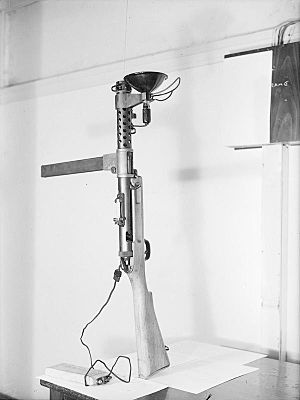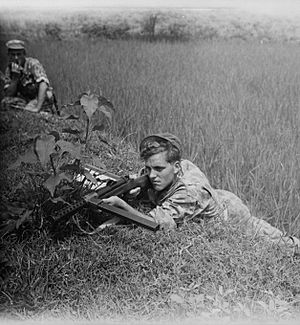Lanchester submachine gun facts for kids
Quick facts for kids Lanchester |
|
|---|---|

Lanchester Mk.1
|
|
| Type | Submachine gun |
| Place of origin | United Kingdom |
| Service history | |
| In service | 1941–1960 |
| Used by | See Users |
| Wars | World War II Indonesian National Revolution Malayan Emergency Mau Mau rebellion Rhodesian Bush War Suez Crisis Dominican Civil War Nigerian Civil War |
| Production history | |
| Designer | George Lanchester |
| Designed | 1940 |
| Manufacturer | Sterling Armaments Company |
| Produced | 1941–1945 |
| Variants | Mk.I, Mk.I* |
| Specifications | |
| Mass | 9.57 lb (4.3 kg) |
| Length | 33.5 in (850.9 mm) |
| Barrel length | 8 in (203.2 mm) |
|
|
|
| Cartridge | 9×19mm Parabellum |
| Action | Blowback, Open bolt |
| Rate of fire | 600 round/min |
| Muzzle velocity | 1,245 ft/s (379 m/s) |
| Effective firing range | 150 m (490 ft) |
| Feed system | 32- or 50-round detachable box magazine |
| Sights | Front blade; rear adjustable |
The Lanchester is a type of submachine gun that was made in the United Kingdom during World War II. It was built by the Sterling Armaments Company from 1941 to 1945. This gun was actually a copy of a German weapon called the MP28/II.
The Lanchester was made in two main versions: the Mk.1 and the Mk.1*. The Mk.1* was a simpler version. This submachine gun was mostly used by the Royal Navy (the British navy) during the war. It was also used a little by the Royal Air Force Regiment to protect airfields. The gun was named after George Lanchester, who was in charge of making it at the Sterling Armaments Company.
Contents
History of the Lanchester Gun
After the Battle of Dunkirk in 1940, the Royal Air Force (RAF) realized they needed a submachine gun to defend their airfields. There wasn't enough time to design a brand new weapon. So, they decided to copy a German gun, the MP 28. They used two examples of this German gun that they found in Ethiopia.
The British Admiralty, which is like the navy's headquarters, also decided to use this new weapon. They helped a lot with its design. In the end, most of the Lanchester guns that were made went to the Royal Navy.
The Lanchester was meant to be used for guarding prisoners. It was also used by naval landing parties and assault teams. It was a very strong and well-made submachine gun. It used high-quality materials. This was quite different from another British gun made at the same time, the Sten.
The Lanchester had a heavy wooden butt and stock. This part was copied from the British SMLE service rifle to make things easier. It also had parts made from machined steel. The magazine holder was first made from solid brass, but later from steel. The gun could also have a long 1907 bayonet attached to its front.
The gun was made in two versions: the Mk.1 and the Mk.1*. The Mk.1* was a simpler version of the original Mk.1. It did not have a switch to choose between firing modes. This meant it could only fire automatically. It also had simpler sights.
How the Lanchester Was Made
The first order for the Lanchester gun was placed on June 13, 1941. This order was for 50,000 Lanchesters. Almost all of these guns were for the Royal Navy. By this time, the British Army had plenty of Thompson SMGs from the United States.
The last order for the Lanchester was given on October 9, 1943. On average, about 3,410 guns were made each month for 28 months.
Some of the Mk.1 guns were changed later in the war. These changed guns were then called Mk.1*. The main changes were removing the fire-selector switch. They also added simpler rear sights. Because of these changes, it's hard to know exactly how many of each model were originally produced.
There were four places where the Lanchester guns were put together. However, only three companies actually had contracts to assemble them. The Sterling company split its work between two factories.
Here are the approximate numbers of guns produced by each main company:
- Sterling (two factories): about 74,579 guns.
- Greener: about 16,990 guns.
- Boss: about 3,900 guns.
How the Lanchester Works
The Lanchester is an "open-bolt" and "blowback-operated" weapon. This means that when you pull the trigger, the bolt moves forward, loads a bullet, and fires it. On early versions, you could choose to fire single shots or automatically. This switch was located in front of the trigger.
The gun had a tube-shaped receiver attached to the front of its wooden stock. This part could be turned down for cleaning and taking the gun apart. The wooden stock was designed like the Lee–Enfield rifle stock. A bayonet could be attached below the muzzle. This was the same type of sword-bayonet used on the Lee–Enfield No. 1 Mk. III* rifle.
The Lanchester used a straight 50-round magazine. This magazine held 9×19mm Parabellum bullets. The magazine fit into the gun from the left side. Empty bullet casings were thrown out on the right side. The Lanchester could also use the shorter 32-round magazines from the Sten gun. A special tool was needed to load both the 32- and 50-round magazines more easily.
The Mk.1 models had a front blade sight. They also had adjustable rifle-type sights that could be set for distances between 100 and 600 yards. The Mk.1* models had much simpler sights. These were flip-up sights marked for either 100 or 200 yards.
The gun had a safety feature that locked the bolt in the open position. However, if the gun was dropped, it could sometimes fire by accident. For cleaning, the gun had a brass oil bottle and a pull-through cleaner. These were kept inside the butt stock, similar to the Lee–Enfield rifle.
When and Where the Lanchester Was Used
The Lanchester was used by the Royal Navy, the Royal Canadian Navy, and other navies from countries in the Commonwealth during and after World War II. The last of these guns left the Royal Naval service in the 1970s. Today, they are often collected by people who like old weapons.
Many Lanchesters were later sold to other countries. These guns often have two broad arrow symbols stamped on them. These arrows point towards each other, looking like a six-pointed star. This symbol, sometimes with the letter "S," means the gun was "Sold out of Service."
Users
 Argentina
Argentina Australia
Australia Biafra
Biafra Chile
Chile Canada: Used by the Royal Canadian Navy until the 1960s.
Canada: Used by the Royal Canadian Navy until the 1960s. Cyprus
Cyprus Dominican Republic: Used by the Constitutionalists in the Dominican Civil War of 1965.
Dominican Republic: Used by the Constitutionalists in the Dominican Civil War of 1965. Egypt
Egypt Greece Hellenic Navy
Greece Hellenic Navy Indonesia (captured from Dutch forces)
Indonesia (captured from Dutch forces) Myanmar: No longer in use.
Myanmar: No longer in use. Netherlands
Netherlands
 New Zealand
New Zealand United Kingdom
United Kingdom
See also



